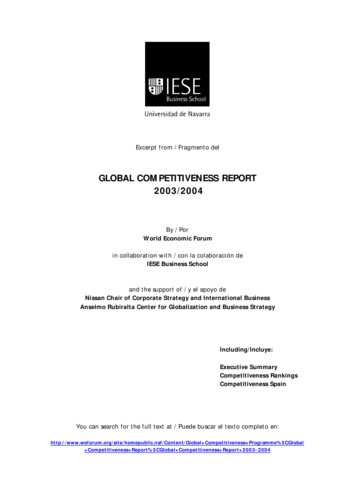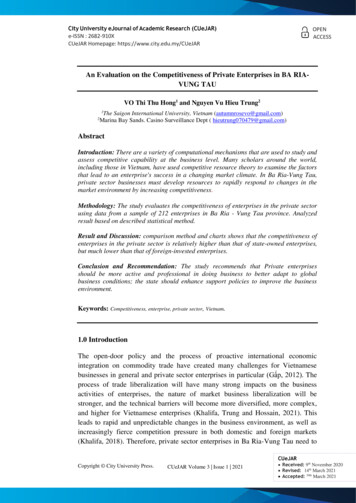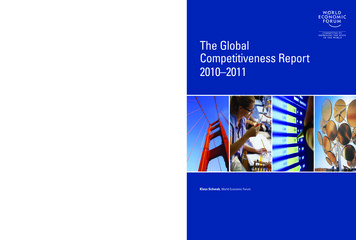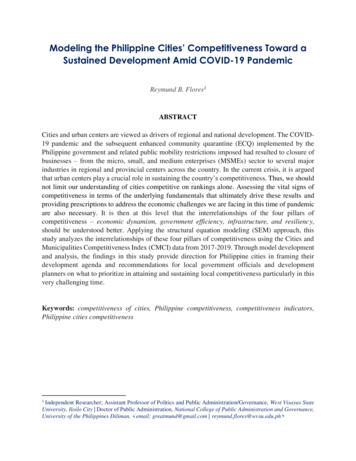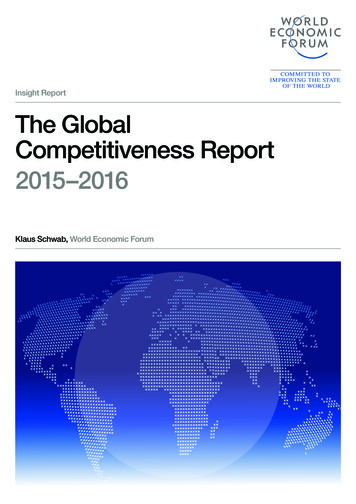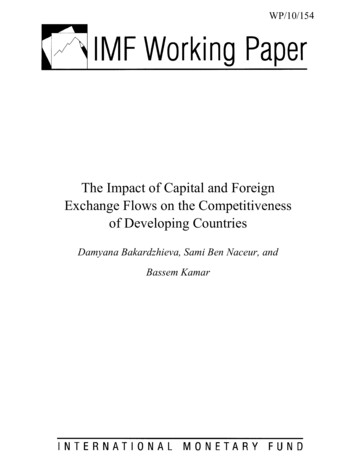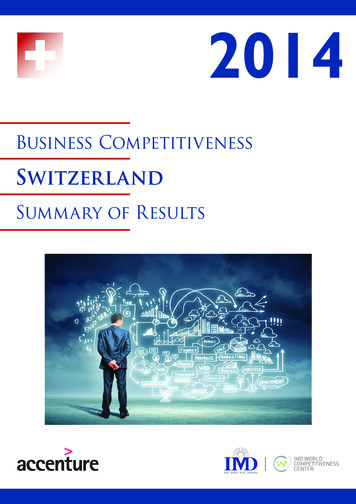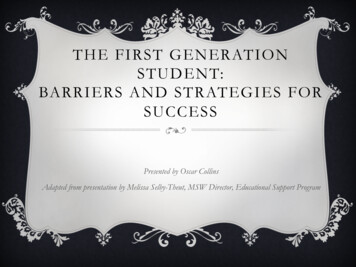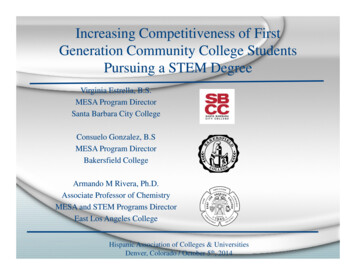
Transcription
Increasing Competitiveness of FirstGeneration Community College StudentsPursuing a STEM DegreeVirginia Estrella, B.S.MESA Program DirectorSanta Barbara City CollegeConsuelo Gonzalez, B.SMESA Program DirectorBakersfield CollegeArmando M Rivera, Ph.D.Associate Professor of ChemistryMESA and STEM Programs DirectorEast Los Angeles CollegeHispanic Association of Colleges & UniversitiesDenver, Colorado / October 5th, 2014
STEM Science, Technology, Engineering, Mathematics
STEM High-level math-based majors Calculus– Science: Biology, Chemistry, Computer Science, EarthScience, Geology, Physics (and Astronomy)– Technology– Engineering: Civil, Electrical & Mechanical Aerospace Engineering Bioengineering Computer Engineering– Mathematics: Applied and Pure
East Los Angeles
The US STEM Education PipelineNational Science Board,2010
The California Latino Transfer Pipeline100%High SchoolGraduates45%HigherEducation4% Universityof ollegeRivas, M.A., et al. (2007, May) AnExamination of Latino/a TransferStudents in California's PostsecondaryInstitutions. Latino Policy & IssuesBrief, UCLA Chicano Studies ResearchCenter, no. 16.3.3 %Transfer0.5% UC2.8% CSU
The California STEM Pipeline in Numbers By 6th grade, students that performed at grade level inmathematics––––35% of African-American41% of Latino/a students67% of White students80% of Asian students. Students that reached proficiency in Chemistry– 18% of African-American– 23% of Latino/a high school students.
The California STEM Pipeline in Numbers Students taking AP exams (2009)– 16% of the Latino/a, who represent roughly half (46%) ofCalifornia’s high school population. Students enrolled in a STEM discipline across all UCcampuses (2009)– 1,551 African-American a 2% of all STEM undergraduates.
The MESA model Mathematics, Engineering, Science Achievement
Mathematics, Engineering and ScienceAchievement (MESA) Program Grant from the California Community CollegeChancellors Office (CCCCO), Funds for StudentSuccess (FSS). Transfer Ready and Academic Support Program.
Mission To provide math, science and engineering academicdevelopment to educationally disadvantagedcommunity college students To ensure that students excel academically andtransfer to a 4-yr university completing a degree inSTEM
Goals & Objectives Increase the number of underrepresented students whograduate in STEM field Increase college retention and transfer to 4-yrinstitutions Provide academic enrichment in STEM Provide and encourage participation in activities that makestudents competitive university applicants Establish a mentoring program which includes faculty,upper division students, and science professionals
Components The 13 tiveStudent CenterStudent ClusteringAcademic CounselingMESA Orientation CourseAcademic Excellence WorkshopsStudent Support ServicesStudent Outreach and identification of participantsMESA Campus CouncilProfessional DevelopmentStudents OrganizationsLocal Business and Industry CouncilPro-Active Liaisons with MSP/MEP and similar programs
About Our colleges Bakersfield CollegeEast Los Angeles CollegeSanta Barbara City College
About Bakersfield College (BC) BC serves about 17,400 students each semester, and is part of the KernCommunity College District (KCCD). The main campus is located on a 153-acre Northeast Bakersfield inCalifornia’s central valley, and it also operates two satellite campuses: theWeill Institute in downtown Bakersfield, shared by the Kern CommunityCollege District, and at the Delano Campus in Delano, California,approximately 35 miles north of Bakersfield. BC is an Hispanic Serving Institution with a population of over 42% Hispanics The student body is low-income, first-generation college-going, minority, andacademically under-prepared.
Facts About BC MESA We serve a population of approximately 151 educationallydisadvantage students each academic year at all academiclevels, of these about 30 successfully transfer each year. By gender Male Female70%30% By ethnicity Latino/a Asian62%13.5% By academic institution California State University System University of California System Private University85%13%2%
About East Los Angeles College (ELAC) The largest college within the Los Angeles Community College District (LACCD),the largest community college system in the US. In 2013-14 ELAC enrolled 54,613 (head-count) students (primarily from feederschools ranked in the bottom 10% of the state) making the 7th largest college in thenation by enrollment. The student population is one of the most diverse in the US, not only with regardto ethnicity but also in age, primary language, enrollment status, and social andeconomic background. Of our students, over 75% of students report financial factors as a barrier toacademic success, while 64% report job obligations as a cause preventing successand 61% report an annual family income of less than 29,000. Approximately 85% report being first-generation and 71% attend on a part-timebasis.
Facts About ELAC MESA We serve a population of 350 educationally disadvantagestudents each academic year, at all academic levels. About 50successfully transfer each year. By gender Female Male43%57% By ethnicity Hispanic Asian64%33% By academic institution California State University System University of California System Private University55%37%8%
About Santa Barbara City College (SBCC) SBCC serves about 18,900 students each semester, and is part of the SantaBarbara Community College District (SBCD), a one district school. SBCC is an Hispanic Serving Institution with a population of 35% Hispanicsof which 921 are declared STEM majors. SBCC surrounding community is considered a bimodal with well-to-doresidents and low-income residents.
Facts About SBCC MESA We serve a population of approximately 100 educationallydisadvantage students each academic year at all academic levels, ofthese about 20 successfully transfer each year. By gender Male75% Female25% By ethnicity Latino/a90% Other10% By academic institution California State University System55% University of California System32% Private University/Other13%
Survey Identifying common challenges & resources
At the student level How is “first generation” defined on your campus? What are challenges that these students face on yourcampus? How important is eligibility versus competitiveness inattaining a STEM degree?
At the programmatic level What are challenges that your program(s) face(s) onyour campus?
At the college level What is the importance of diversity in STEM at yourcollege? How does the institution and the community benefitfrom HSI STEM programs in STEM?
Possible answers:At the student level How is “first generation” defined on your campus?– Neither parent have a bachelor degree or equivalentdegree in any country– Parents do not understand college– First person in the family to attend college– Special populations
Possible answers:At the student level What are challenges that these students face on yourcampus?––––––––––Financial aidMath acting as a gate keeperLack of role models both Faculty and StudentsLack of educational and career planningUnder preparation from high school assessing at low levelmathFamily ObligationsEmployment IssuesKnowledge of educational systemWork hoursLow confidence levels
Possible answers:At the student level How important is eligibility versus competitiveness inattaining a STEM degree?––––––Financial aid opportunitiesTransfer processResearch & internship opportunitiesJob opportunitiesLeadership opportunities (training)Individual and community empowerment
Possible answers:At the programmatic level What are challenges that your program(s) face(s) onyour l supportFaculty supportAdministrative supportSpaceAdequate staffing: staff, tutors, counselors, advisors, etc.Professional developmentParent involvementUnderstanding of the project/grants identified goals, objectives andactivities in order to produce appropriate deliverables– Quantity versus quality: students served, programming, etc.
Possible answers:At the college level What is the importance of diversity in STEM at yourcollege?––––Increase national competitivenessProvide a different point of view on scientific issuesProvide equity for minority groupsChallenge is understanding that diversity is not reversediscrimination
Possible answers:At the college level How does the institution and the community benefitfrom HSI STEM programs in STEM?– Increase visibility and quality of programs– Leverage for funding from: Grants Foundations Industry
Grants The institution becomes eligible and competitive bydemonstrating:– Positive outcomes and deliverables from identified activities– Fiscal accountability– Proven research track that may allow to: Eligibility for extensions Increase competitiveness for new project for expansion ofproven activities Open new doors with new granting agencies Many grants allow for additional administrators, facultyand staff; strengthening the implementation infrastructureof the college
Industry Possible Industry funding sources that support MESA andSTEM programs.–––––Local Business and Industry CouncilCorporate Education FundingAlumniCommunity Partnership with IndustryEmployee match funding
Foundations Now Foundations have leverage and proven programs ofsuccess that may facilitate their work when approaching:– Individual Donors– Industry– Local Foundations Santa Ynez Chumash Wood-Claeyssen– Scholarships
Acknowledgements MESA Programs– BC, CCCCO 14-109-008– ELAC, CCCCO 14-109-012– SBCC, CCCCO 14-109-022 BC STEM Programs– US ED, Title III, STEM Grant ELAC STEM Programs– NSF STEP Award, DUE – 1068483– US. ED – Title V, HSI P031C110092-12
Questions Virginia Estrella – Santa Barbara City College– estrella@sbcc.edu Consuelo Gonzalez – Bakersfield College– cogonzal@bakersfieldcollege.edu Armando M. Rivera – East Los Angeles College– riveraam@elac.edu
Weill Institute in downtown Bakersfield, shared by the Kern Community College District, and at the Delano Campus in Delano, California, approximately 35 miles north of Bakersfield. BC is an Hispanic Serving Institution with a population of over 42% Hispanics The student body is low-income, first-generation college-going, minority, and
